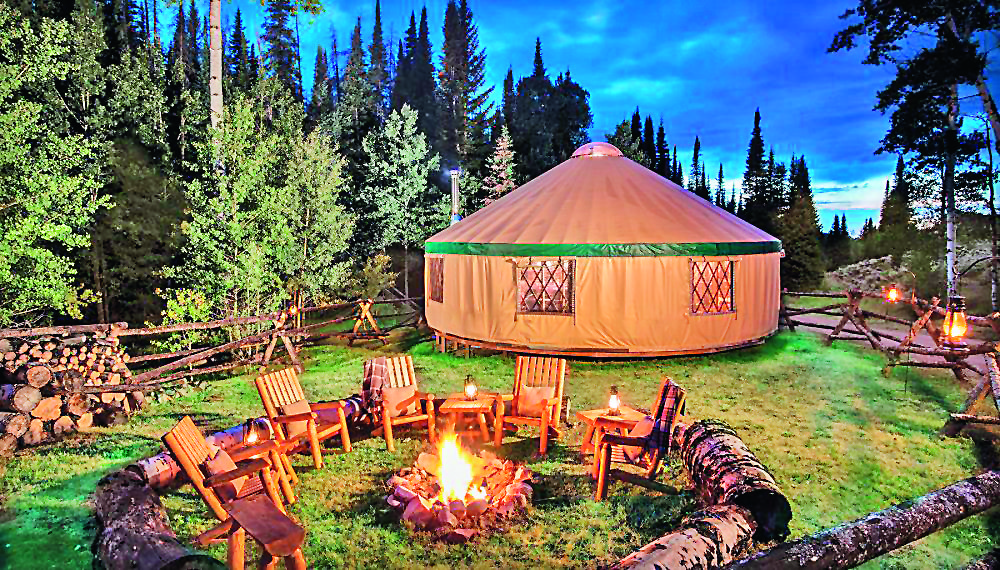Yurts: Camping in luxury

Nostalgia, adventure, and a touch of ‘childhood whimsy’ are driving the trend as yurts become a sought-after breather choice. (Image by arrangement)
With luxury yurts, travellers now opt for more meaningful and personalised getaways beyond the typical tourist experience. Industry data shows a steady rise in the popularity of experiential stays as travellers increasingly seek faithful connections with local culture and nature.
Keith Menon, co-owner of eco-friendly property Circle in Goa and a sustainable architect, explains the design philosophy behind yurts. “We craft yurts to blur the line between indoors and outdoors. The large windows and open spaces are not just architectural choices but a way to invite nature in. Imagine waking up to the soft glow of the sunrise right from your bed or lying there at night listening to the rustling trees and distant bird calls. The small moments immerse you fully in your surroundings. The yurt becomes a conduit to a deeper connection with the natural world,” he says.
For Menon, the setup is about more than aesthetics. “When people come to stay, they’re not just seeking comfort — they want to feel something genuine. They can engage more intimately with the environment, breathe it in, pause, and be present thanks to the yurt’s structure. It’s this balance of simplicity and immersion that makes it so powerful.”
Perfect solution
Likewise, Sandeep Singh, founder of Rubystone Hospitality says, yurts stand out as the best pick for eco-friendly and frill accommodations due to their uninterrupted unification with nature, sustainable structure, and ability to offer guests a sense of environmental consciousness. He explains that as more people become committed to reducing their ecological footprint, they seek lodgings that reflect this mindset. Yurts provide a perfect solution.
Perfect solution
Likewise, Sandeep Singh, founder of Rubystone Hospitality says, yurts stand out as the best pick for eco-friendly and frill accommodations due to their uninterrupted unification with nature, sustainable structure, and ability to offer guests a sense of environmental consciousness. He explains that as more people become committed to reducing their ecological footprint, they seek lodgings that reflect this mindset. Yurts provide a perfect solution.
Ecologically dedicated
“In India, yurts are becoming increasingly popular for several reasons. As travelers become more environmentally conscious, they gravitate towards accommodations that have minimal ecological impact. Yurts offer this in a serene setting, drawing tourists from outside and domestically who are looking for alternatives to traditional hotel stays,” says Sandeep, who also adds that advancements in yurt construction, like water-resistant materials and climate control systems, have made them adaptable to challenging climates. “India’s varied climates make it difficult to introduce and maintain yurts due to issues with ventilation, insulation, and weatherproofing. Extremely hot places need integrated cooling systems, and frigid places need well-insulated spaces to keep people comfortable, he says adding, “ Furthermore, to avoid wear and tear, excessive humidity or monsoon conditions call for sturdy materials and routine maintenance. However, recent advancements in yurt construction have made them suitable for use in a variety of climates.”
Construction
* A yurt is a circular, portable shelter constructed with a lattice of flexible poles and covered in felt or other fabric.
* They are a durable and dependable variety of tents.
* For centuries, yurts have served as the main type of residence in Central Asia, especially in Mongolia.
* Setting up or taking down a yurt typically takes anywhere from 30 minutes to 3 hours, and it can accommodate a group of five to 15 individuals.
* Typically, they stand just over 2 meters tall (equivalent to 6 feet) and have a slightly rounded peak that extends another meter upward.
* In the centre of a traditional yurt stands a wood-burning iron stove, with a tall chimney extending above the roof.
* They are a durable and dependable variety of tents.
* For centuries, yurts have served as the main type of residence in Central Asia, especially in Mongolia.
* Setting up or taking down a yurt typically takes anywhere from 30 minutes to 3 hours, and it can accommodate a group of five to 15 individuals.
* Typically, they stand just over 2 meters tall (equivalent to 6 feet) and have a slightly rounded peak that extends another meter upward.
* In the centre of a traditional yurt stands a wood-burning iron stove, with a tall chimney extending above the roof.
"Yurts stand out as the best pick for eco-friendly and frill accommodations due to their uninterrupted unification with nature, and ability to offer guests a sense of environmental consciousness." — Sandeep Singh, founder, Rubystone Hospitality
( Source : Deccan Chronicle )
Next Story

